On June 29, 2023, in order to commemorate the Stonewall Inn Revolt that took place on June 28, 1969 in New York, and which represents the birth of the LGTBQI+ movement, a participatory choral ceremony in three parts took place at the La Posta Foundation, in Plaza de la Santa Cruz and in the nearby streets in Valencia:
First: inside La Posta, projection of the video art piece “Invocation of the Wayward Saints” (6′, 2005), by Graham Bell Tornado, a tribute to outsider and queer artists (it can now be seen on the web here).
Second: in the Plaza de la Santa Cruz, a participatory action based on the vocal expression of slogans used in demonstrations. The basis of this choral action is a kind of queer songbook, written between the pages of a book of Catholic masses, which takes as its raw material slogans from demonstrations and eco-transfeminist songs made for the event, whose texts covered the walls of the streets adjacent to the La Posta Foundation in the previous days, in the form of urban art, to infect the neighbourhood with their queer propaganda.
Third: back to La Posta, “Kuiraoke”, a karaoke of queer songs, chosen by the participants, presented by Diana DAMG, DJ and trans activist.
The organization of performative rituals is a type of action with a long tradition and that has been used in very different contexts, not only artistic ones, but also in many other contexts, generally with a strong symbolic and spiritual content. The staging of rituals is almost always intended to empower its participants in the conviction of the ideas of the community that unites them, thus it is often common to use what is known in German as Sprechgesang, a technique used in vocal music where the singer is required to use the voice in an expressive way halfway between speaking and singing. This way of speaking/singing has been used in both high and low culture. Thus, for example, during the 20th century, musicians of the atonal and twelve-tone current made abundant use of this technique, such as Arnold Schönberg and Alban Berg, practitioners of an aesthetic linked to expressionism.
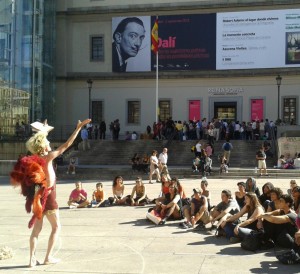
“How to Heal…” Ritual by Graham Bell Tornado at the Reina Sofia [MNCARS], during the great Salvador Dalí exhibition in 2013.
In the case of Graham Bell Tornado, in their ritual actions they take advantage of their singing skills (regularly used in their cabaret /drag shows ―probably the only drag that does not limit themself to lipsynching while some iconic queer song is playing through the speakers ―in addition to La Prohibida, who also sings their own songs―), so that for the ritual action “InsuMisa”, Graham displayed their know-how in the field of Sprechgesang, infecting the audience, who joined in a perfectly organized choral performance, including the positioning of the different groups: high voices on the left and low voices on the right (therefore not using the criteria usually followed in the organization of choirs, which separates and positions women and men ―in front and behind, respectively―).
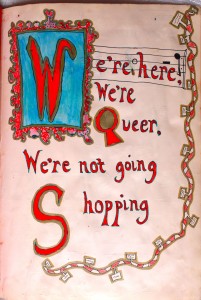

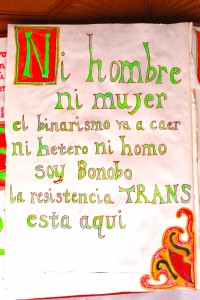

On the other hand, the ritual action “InsuMisa” is part of a series of ritual actions or performances based on recycled books, saved from the dump and intervened that began in 2009. Graham Bell Tornado defines these book-based rituals and performance actions as follows:
The “book-actions” are based around the elements that form a book, both the contents ―the text and images― and the support: the sections, back cover, tarlatan, thread, pleats, etc. From these elements, work is carried out using a variety of techniques including drawing, calligraphy, paper engineering and performance. Thus, apart from the elements of its physical support, the “action-book” can incorporate elements of video, music and performance in an assemblage which expands beyond its covers.
Action books are a form of resistance against the dictatorship of the screen, the forced withdrawal from reality that encloses us in a virtual world where we control each other and where we seem to be repeatedly witnessing one final extravagant spectacle: the apocalypse. But as long as there is a real world, as long as there is something outside the screen, we have to fight so that both culture and a decent life is a possibility for everyone. Book actions. http://www.grahambelltornado.com/recyclopedia/book-actionlibro-acciones/
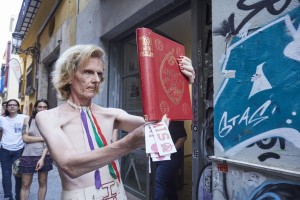
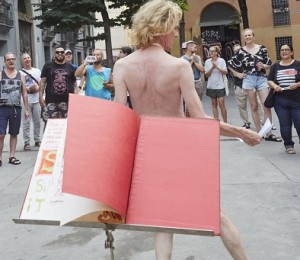
Claude Lévi-Strauss, a great scholar of rituals, comments in his book Wild Thought (1962):
“The refinements of the ritual, which may seem idle when examined superficially, or from the outside, are explained by the concern for what we could call a “micro-perecuation” [perequation is understood, a term used in the field of urbanism, the equitable distribution of burdens among those who bear them; In conclusion, treat members of a group equally]: not letting any being, object or aspect escape, in order to assign it a place within a class. In this respect, the hako ceremony of the Pawnee Indians is particularly revealing only because it has been well analysed. The invocation that accompanies the crossing of a stream of water is divided into several parts, corresponding respectively to the moment in which the travelers put their feet in the water, in which they move them, in which the water completely covers their feet; the invocation to the wind separates the moments in which the coolness is perceived only on the wet parts of the body, then here, then there, and finally on the entire epidermis: “only then can we advance safely” [Fletcher, 1904, p. 77-78]” [Lévi-Strauss, p. 26 in the Spanish edition FCE of 2005].
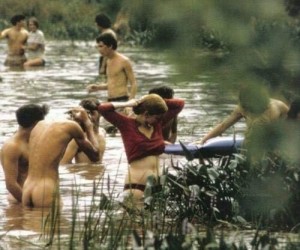
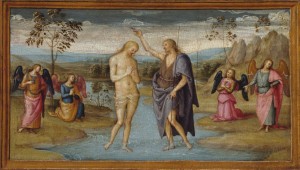
The ritual of entering the river as a healing passage that will take us safely along our path in life, is an image that is repeated tirelessly throughout history. Above left, iconic image of participants in the Woodstock Festival (probably one of the greatest rituals of the 20th century), which took place in the summer of 1969, probably taken at the small Filippini lake behind where the main stage used to be, in Bethel Township, Sullivan County, New York State. A space of exuberant nature, with a strong presence of water in lakes and tributary rivers of the Delaware. The conjunction of this landscape with the spirit generated by this festival of music, love and peace (people were very sensitive to the Vietnam War, one of the last colonial wars), created an environment particularly conducive to healing rituals, which included entering the water, invoking the wind at the moment when the coolness is felt on the wet parts of the body, as the Pawnee Indians did before. It is an image that is much like updating another image, also a healing ritual, of those who, following John, went to the Jordan River in Palestine, including Jesus, twenty centuries ago [above right, “The Baptism of Christ” (1500-05), predella by Pietro Perugino, preserved at the Art Institute of Chicago].
However, the ritual action of Graham Bell Tornado “InsuMisa” does not have so much the characteristics of a healing ritual ―which also exists, when they invite the participants to put a bracelet on their wrist and thus enter into the circle of resistance, as someone new who has left behind a past of submission to binary social conventions (which includes the confrontation between culture and nature), washing the dirt from their souls produced by lies―, but it has more of a ritual of empowerment of the participants in the idea that they are in a material (non-digital) reality, represented in an old book that is given a new use, by turning it into the basis for a new calligraphy that gives body to “abracadabrant” proclamations, in a process of embodiment of speech by claiming for them a pronunciation that is also a bit of a song. All of which is very physically and sensorially powerful. At the same time, having been made with few external resources, it is easy to qualify as a form of arte povera.
Going back to the beginning, and to the speech/song that accompanies the rituals of Graham Bell Tornado, there is one in his artistic career which sprung directly from the origin of this popular form of ritualistic artistic expression which is the action “Scottish Hysterics and The Keening Women Tour” (2017).
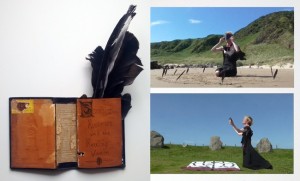
The Keening is a traditional form of vocal lamentation for the dead in the Gaelic Celtic tradition, known to have taken place in Ireland and Scotland. A lament that can be seen as a form of sean-nós chant, is performed in the Irish and Scottish Gaelic languages (the Scottish equivalent of lament is known as a coronach). In the 20th century it almost disappeared, after having been persecuted by the Scottish Church from the 18th century “since the women who carried it out were thought to be savages who had been possessed by the devil” (according to Graham Bell Tornado on their blog). But it has been recovered in recent decades. In popular Spanish culture, both the lamentation at funerals (the mourners) and the speaking/singing in communion rituals are also known (it has been practiced by Basques ―the bertsolaris―, Galicians and Andalusians ―especially in the Alpujarras―, among others), although influenced by the prevailing musical contexts in the respective popular spheres, it also shares in that general tone towards sung speech. And as such spoken sung, sometimes performed as a duet. Exported to Latin America after colonization, it has reached a sui generis materialization known as Payada, where it takes the form of a kind of duel in which each “payador” asks the other questions, which they must answer, and so on for hours, even days. It ends when one of the “payadores” does not respond immediately.
But in “InsuMisa” there are not only ancestral songs, but the action includes, finally, a “Kuiraoke”, a karaoke of queer songs conducted by Diana DAMG, through which an important part of the fagot musical imagination, which goes from the camp to the most frenetic punk, is incorporated into the whole ritual. Configuring all this an amalgamation of images and sounds that give the participant an unusual feeling of freedom.
Eugen Ehrlich
“Morbo Queer / InsuMisa” by Anna Maria Staiano and Graham Bell Tornado: between Eros and Thanatos

